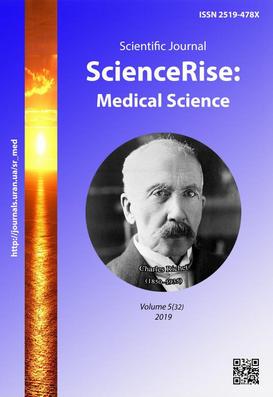Application of the concept of the hospital safety index taking into account clinical risks in assessing the level of hospital safety in Ukraine
DOI:
https://doi.org/10.15587/2519-4798.2019.179772Keywords:
Hospital Safety Index, levels of safety, emergencies, clinical risk, crisis managementAbstract
The aim of the study. Provision the increasing hospitals safety in Ukraine by identifying and assessing the risk creating factors, organizational, structural, functional readiness of institutions ability to function effectively in providing medical assistance to victims in emergency situations (ЕS).
Materials and methods of research. The research is based on the analysis of official WHO expert reports, information from special and scientific sources, namely: International Disaster Database (EM-DAT), Center for Natural Disaster Epidemiology Studies at the Catholic University of Leuven (Belgium), safety assessment reports Kiev City Clinical Hospital Emergency Medical Services (KCCHEMS) in 2012 and 2017.
The research methods were: formal logic methods, bibliographic, experts review and evaluation, risk management and full-scale modelling. For the first time the adapted classification of HSI has been applied, taking into account the values of clinical risk, which is based on a methodology for identifying risks as an element of crisis management.
Research results. The overall safety of KCCHEMS , assessed by the existing classification of HSI in both 2012 and 2017, is at a high level (A), meaning that further activities - work on the plan, the hospital will function during the ES. When applying our proposed clinical risk classification, we have significantly different results: in 2012, a C (critical risk) score, meaning that the hospital needs immediate action to increase its capacity to respond to emergencies, there is a high likelihood of termination functioning of the hospital under such conditions; in 2017 - at level B (significant risk): correction of the proposed measures is required, there is a likelihood of termination of hospital operation in the event of ES. Thus, the incomplete result of improving the safety of the KCCHEMS from the implementation of the recommended measures in 2012, which was established during the re-evaluation of this hospital in 2017, may be due not only to the incomplete implementation of these measures, but also to their speed of implementation and depth, which also proves the need for a correction of the 2017 Hospital Action Plan to improve hospital safety.
Conclusions. Methodology of determining the Hospitality Safety Index, recommended by WHO, is appropriate to apply in Ukraine, increasing its effectiveness is possible with the application of the adapted classification the HSI levels, taking into account clinical risks
References
- Wallemacq, P., House, R. (2018). UNISDR and CRED report. Economic Losses, Poverty and Disasters 1998–2017. Brussels: Centre for Research on the Epidemiology of Disasters (CRED), 31. Available at: https://www.preventionweb.net/files/61119_credeconomiclosses.pdf Last accessed: 1408.2018
- UNDRR. UN 20-year review: earthquakes and tsunamis kill more people while climate change is driving up economic losses (2018). Geneva: United Nations Office for Disaster Risk Reduction (UNDRR). Available at: https://www.unisdr.org/archive/61121 Last accessed: 10.10.2018
- Guha-Sapir, (2019). 2018 Reviev of disaster events. Brussels: Center for Disaster Epidemiology Research (CRED) of Leuven Catholic University (Belgium), EM-DAT (International Disaster Database) is partly funded by USAID, 6. Available at: https://cred.be/sites/default/files/Review2018.pdf
- DSNS. Zvit pro osnovni rezultaty diialnosti Derzhavnoi sluzhby Ukrainy z nadzvychainykh sytuatsii u 2018 rotsi (2019). Derzhavna sluzhba Ukrainy z nadzvychainykh sytuatsii, 45. Available at: https://www.dsns.gov.ua/files/2019/1/18/321/Публічний%20звит%20за%202018%20рік.pdf Last accessed: 18.01.2019
- Huryev, S. O., Shevchuk, H. A., Satsyk, S. P. (2019). Hospital Safety Index. Practice of the medical institution management, 6 (100), 70–76.
- Wahlström, M. (Ed.) (2015). Sendai Framework for Disaster Risk Reduction 2015 – 2030. Proceedings of theThird UN World Conference on Disaster Risk Reductoin: Sendai, Miyagi Prefecture, Japan: 2015 March 18. Geneva: United Nations Office for Disaster Risk Reduction, 32.
- WHO. Save lives. Make hospitals safe in emergencies. World Health Day 2009 (2009). Geneva: World Health Organization, 36. Available at: https://www.who.int/world-health-day/2009/whd2009_brochure_en.pdf?ua=1 Last accessed: 07.04.2009
- PAHO. Hospital Safety Index: Medium and Small Hospitals Safety Index. Series: Hospitals Safe for disaster No. 4. (2015). Washington: Pan American Health Organization, 141. Available at: https://www.paho.org/disasters/index.php?option=com_docman&task=doc_download&gid=2389&Itemid=&lang=en
- Hospital safety index: guide for evaluators (2015). Geneva: World Health Organization and Pan American Health Organization, 176. Available at: https://www.who.int/hac/techguidance/hospital_safety_index_evaluators.pdf Last accessed: 20.09.2017
- Huriev, C. O., Terentieva, A. V., Volianskyi, P. B. (2008). Kryzovyi menedzhment ta pryntsypy upravlinnia ryzykamy v protsesi likvidatsii nadzvychainykh sytuatsii. Kyiv: PP «SKD», 148.
- Terent'evа, A. V. (2015). Emergency management with the elements of crisis management. Public administration: improvement and development, 9. Available at: http://www.dy.nayka.com.ua/?op=1&z=881
Downloads
Published
How to Cite
Issue
Section
License
Copyright (c) 2019 Hanna Shevchuk, Sergiy Guriev

This work is licensed under a Creative Commons Attribution 4.0 International License.
Our journal abides by the Creative Commons CC BY copyright rights and permissions for open access journals.
Authors, who are published in this journal, agree to the following conditions:
1. The authors reserve the right to authorship of the work and pass the first publication right of this work to the journal under the terms of a Creative Commons CC BY, which allows others to freely distribute the published research with the obligatory reference to the authors of the original work and the first publication of the work in this journal.
2. The authors have the right to conclude separate supplement agreements that relate to non-exclusive work distribution in the form in which it has been published by the journal (for example, to upload the work to the online storage of the journal or publish it as part of a monograph), provided that the reference to the first publication of the work in this journal is included.









